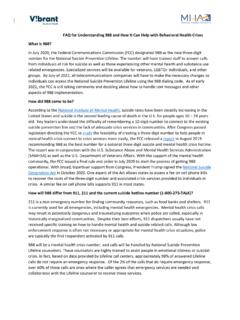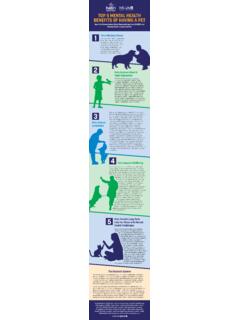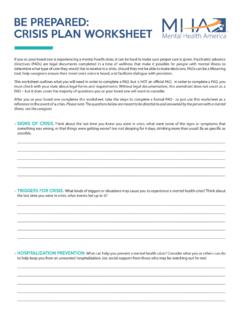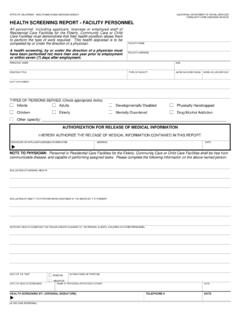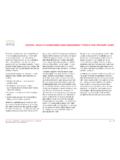Transcription of Executive Summary - Mental Health America
1 Executive Summary From January to September 2020, 1,560,288 people took a screen and accessed immediate resources and supports through the MHA Online screening Program. From those screens, we have found: The number of people looking for help with anxiety and depression has skyrocketed. From January to September 2020, 315,220 people took the anxiety screen, a 93 percent increase over the 2019 total number of anxiety screens. 534,784 people took the depression screen, a 62 percent increase over the 2019 total number of depression screens. The number of people screening with moderate to severe symptoms of depression and anxiety has continued to increase throughout 2020 and remains higher than rates prior to COVID-19. In September 2020, the rate of moderate to severe anxiety peaked, with over 8 in 10 people who took an anxiety screen scoring with moderate to severe symptoms.
2 Over 8 in 10 people who took a depression screen have scored with symptoms of moderate to severe depression consistently since the beginning of the pandemic in March 2020. More people are reporting frequent thoughts of suicide and self-harm than have ever been recorded in the MHA screening program since its launch in 2014. Since the COVID-19 pandemic began to spread rapidly in March 2020, over 178,000 people have reported frequent suicidal ideation. 37. percent of people reported having thoughts of suicide more than half or nearly every day in September 2020. Young people are struggling most with their Mental Health . The proportion of youth ages 11-17. who accessed screening was 9 percent higher than the average in 2019. Not only are the number of youth searching for help with their Mental Health increasing, but throughout the COVID-19 pandemic youth ages 11-17 have been more likely than any other age group to score for moderate to severe symptoms of anxiety and depression.
3 Rates of suicidal ideation are highest among youth, especially LGBTQ+ youth. In September 2020, over half of 11-17-year-olds reported having thoughts of suicide or self-harm more than half or nearly every day of the previous two weeks. From January to September 2020, 77,470 youth reported experiencing frequent suicidal ideation, including 27,980 LGBTQ+ youth. People screening at risk for Mental Health conditions are struggling most with loneliness or isolation. From April to September 2020, among people who screened with moderate to severe symptoms of anxiety or depression, 70 percent reported that one of the top three things contributing to their Mental Health concerns was loneliness or isolation. People who identify as Asian or Pacific Islander are searching for Mental Health resources more in 2020 than ever before. The proportion of screeners identifying as Asian or Pacific Islander increased 7.
4 Percent, from 9 percent of screeners in 2019 to 16 percent in 2020. While rates of anxiety, depression, and suicidal ideation are increasing for people of all races and ethnicities, there are notable differences in those changes over time. Black or African American screeners have had the highest average percent change over time for anxiety and depression, while Native American or American Indian screeners have had the highest average percent change over time for suicidal ideation. 2. A Growing Crisis The State of Mental Health in America report is designed to create a complete picture of Mental Health throughout the United States that can be used to track the successes and failures of federal and state policy initiatives aimed at affecting Mental Health outcomes over time. In 2015 when this initiative was created, we did not anticipate that there would be a population-level Health crisis that would change the landscape of Mental Health in every community throughout the United States, with effects of for years to come.
5 As COVID-19 spread throughout the United States, it not only resulted in greater morbidity and mortality in terms of physical Health but also had disastrous effects on the Mental Health of the nation. As opposed to previous disasters in the United States that affected certain specific regions or populations where aid and trauma response could be concentrated, the COVID-19 pandemic has affected the entire population of the country. While the risk of contracting the disease itself is a population-wide traumatizing event, our physical and social environments have changed as well, leading to greater rates of isolation and loneliness, financial hardship, housing and food insecurity, and interpersonal violence. Further, the COVID-19 pandemic has highlighted and exacerbated existing inequities and injustices faced primarily by black, indigenous, and people of color (BIPOC). in the United States.
6 Any of these factors by themselves can negatively affect the Mental Health of individuals, but in combination they have created a nationwide Mental Health crisis. The data presented throughout the State of Mental Health in America 2021 report was collected in 2017-2018. and are the most current data reported by states and available to the public. While they are useful in providing comparative baselines in the states for needs and prevalence rates prior to COVID-19, they do not reflect the state of the nation since the onset of the pandemic. In 2014, Mental Health America created the Online screening Program ( ), a collection of ten free, anonymous, confidential and clinically-validated screens that are among the most commonly used Mental Health screening tools in clinical Through September 2020, over 6 million people have taken a screen, including over million people from January-September 2020.
7 This makes it the largest dataset ever collected from a help-seeking population experiencing Mental Health conditions. The screening results also comprise one of the largest datasets collecting national Mental Health information in real-time, allowing us to recognize and react to changes in the Mental Health of the nation as they occur, including the mounting Mental Health crisis throughout the COVID-19 pandemic. Strengths and Limitations The MHA screening dataset collects information from a help-seeking population, meaning people searching for Mental Health resources and supports online. As a result, users are more likely to screen positive or moderate to severe for Mental Health conditions than the general population. The MHA screening Program also exists entirely online, and therefore does not reflect the Mental Health needs of people who do not have access to Internet services, likely undercounting communities at higher risk of Mental Health challenges, such as people experiencing homelessness, poverty, and institutionalization, and communities that do not have broadband access.
8 MHA screening however, by existing in an online space, can capture information about individual's Mental Health needs earlier than other datasets. From January-September 2020, 66 percent of people who screen positive or 1 These screens include the Patient Health Questionnaire-9 item (PHQ-9) for depression and the Generalized Anxiety Disorder-7 item (GAD-7) for anxiety, the long forms of the same tools used by the CDC to measure depression and anxiety in the Household Pulse Survey. 3. moderate to severe for a Mental Health condition have never received a Mental Health diagnosis before, and 61. percent have never received any form of Mental Health treatment or support. When people first begin experiencing symptoms of a Mental Health condition, they often look for answers, resources and supports online, long before speaking to a provider. The average time between onset of Mental Health symptoms and diagnosis and treatment of a Mental Health condition is 11 The data from MHA screening capture the Mental Health needs of people who either may not have access to care or have not engaged in care in healthcare settings, which allows for it to be used for earlier intervention and detection of Mental Health concerns before they become crises.
9 The following analysis is of the data collected from over million screeners who sought help from MHA. screening from January-September 2020. Basic Demographics 1,560,288 people took a screen through MHA screening from January-September 2020. Of those the majority took a depression screen (34 percent), followed by the anxiety screen (20 percent) and the bipolar screen (17. percent). 73 percent of screeners identified as female, 25 percent identified as male and 2 percent identified as another gender. In April 2020, we added a separate option to identify as transgender. 3 percent of screeners (N=38,090). from April to September 2020 identified as transgender. 2. Wang, et al. (April 2004). Delays in initial treatment contact after first onset of a Mental disorder. Health Services Research, 39(2): 393-416. Doi: 4. People who accessed screening in 2020 were younger than the 2019 average.
10 38 percent of screeners from January-September 2020 were youth ages 11-17, a 9 percent increase over 2019 (29 percent). While the MHA. screening population has always been young with over 60 percent of screeners under the age of 25, this indicates that youth under the age of 18 were even more likely to be searching for Mental Health resources and supports in 2020. The percentage of 18-24-year-olds remained the same from 2019 to 2020 (32 percent). There have also been changes in the race/ethnicity of screeners in 2020, as compared to 2019. The proportion of screeners identifying as Asian or Pacific Islander increased 7 percent, from 9 percent of screeners in 2019 to 16 percent in 2020. Anti-Asian discrimination increased significantly in the during the COVID-19 pandemic, and the increase in Asian or Pacific Islander screeners is consistent with research predicting negative Health effects among Asian Americans as a result of The percentage of screeners identifying their race as Other increased as well, from 3 percent to 5 percent.
